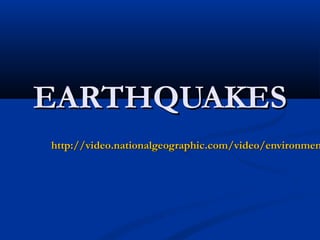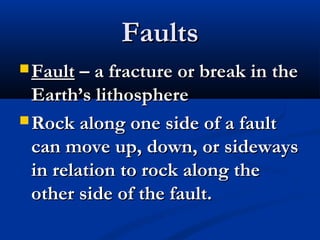Earthquakes revised
- 2. FaultsFaults ïŪ FaultFault â a fracture or break in theâ a fracture or break in the Earthâs lithosphereEarthâs lithosphere ïŪ Rock along one side of a faultRock along one side of a fault can move up, down, or sidewayscan move up, down, or sideways in relation to rock along thein relation to rock along the other side of the fault.other side of the fault.
- 3. How faults formHow faults form ïŪ Forces cause rocks to bend & stretchForces cause rocks to bend & stretch ïŪ Stress is the force exerted when a rockStress is the force exerted when a rock presses on, pulls on, or pushes againstpresses on, pulls on, or pushes against another rockanother rock ïŪ As stress increases, the rocks mayAs stress increases, the rocks may break.break. ïŪ The break in the rock causes faults toThe break in the rock causes faults to form.form.
- 4. EarthquakesEarthquakes ïŪ EarthquakeEarthquake â the vibrations orâ the vibrations or sudden movements produced bysudden movements produced by the breaking of rock.the breaking of rock. ïŪ Most earthquakes result fromMost earthquakes result from rocks moving over, under, orrocks moving over, under, or past each other along faultpast each other along fault surfaces.surfaces.
- 5. EarthquakesEarthquakes ïŪ How do earthquakes actuallyHow do earthquakes actually occur?occur? ïŪ As rocks (plates) move pastAs rocks (plates) move past each other along a fault, theireach other along a fault, their rough surfaces catch,rough surfaces catch, temporarily stoppingtemporarily stopping movement.movement.
- 6. EarthquakesEarthquakesïŪ Forces keep driving the rocks to move,Forces keep driving the rocks to move, and stress builds up.and stress builds up. ïŪ The stress causes the rocks to bend andThe stress causes the rocks to bend and change shape, eventually breaking andchange shape, eventually breaking and causing an earthquake.causing an earthquake. ïŪ The strength of an earthquakeThe strength of an earthquake depends on: the amount of stressdepends on: the amount of stress that builds & the distance the rocksthat builds & the distance the rocks move along the faultmove along the fault
- 9. Types of FaultsTypes of Faults ïŪ Three types of forces ânormal,Three types of forces ânormal, reverse, & strike-slip faultsreverse, & strike-slip faults ïŪ Normal â pulls rocks apartNormal â pulls rocks apart ïŪ Reverse â squeezes rocks togetherReverse â squeezes rocks together ïŪ Strike-slip â causes rocks to slideStrike-slip â causes rocks to slide past each otherpast each other
- 10. Normal FaultsNormal Faults ïŪ A break in rock caused byA break in rock caused by tension forcestension forces.. ïŪ Rock above the fault surfaceRock above the fault surface movesmoves downwarddownward in relation toin relation to rock below the fault surface.rock below the fault surface.
- 16. Reverse FaultsReverse Faults ïŪ A break in the rock caused byA break in the rock caused by compression forces.compression forces. ïŪ The rock above the fault planeThe rock above the fault plane movesmoves upwardupward relative to therelative to the rock below the fault surface.rock below the fault surface.
- 19. Strike-Slip FaultsStrike-Slip Faults ïŪ ShearShear forces push on rock inforces push on rock in oppositeopposite directions.directions. ïŪ Rocks on either side of the faultRocks on either side of the fault movemove past each otherpast each other (without(without much upward or downwardmuch upward or downward movement).movement). ïŪ Ex. San Andreas FaultEx. San Andreas Fault
- 23. Energy from Earthquakes Travels through Earth ïŪ Waves carryWaves carry energyenergy!!!! ïŪ The energy from an earthquakeThe energy from an earthquake travels astravels as seismic wavesseismic waves, which, which cause the vibrations during ancause the vibrations during an earthquake.earthquake.
- 24. Focus & Epicenter ïŪ TheThe focusfocus of an earthquake is the pointof an earthquake is the point underground where rocks 1underground where rocks 1stst begin to move.begin to move. ïŪ TheThe epicenterepicenter is the point on Earthâs surfaceis the point on Earthâs surface directly above the focus.directly above the focus.
- 25. Primary WavesPrimary Waves ïŪ P wavesP waves ïŪ FastestFastest seismic wavesseismic waves ïŪ 11stst to reach any location after anto reach any location after an earthquakeearthquake ïŪ Can travel throughCan travel through solids,solids, liquids, and gasesliquids, and gases
- 26. Secondary WavesSecondary Waves ïŪ SS waveswaves ïŪ 22ndnd wave to arrive at any locationwave to arrive at any location ïŪ Travel atTravel at Â― the speed of P wavesÂ― the speed of P waves ïŪ Can travel throughCan travel through solidsolid (rocks) but(rocks) but NOT throughNOT through liquid and gasesliquid and gases
- 27. Surface WavesSurface Waves ïŪ Move alongMove along Earthâs surfaceEarthâs surface, but, but NOT through itsâNOT through itsâ interiorinterior ïŪ Causes the largestCauses the largest groundground movementsmovements & the most& the most damagedamage ïŪ They make the groundThey make the ground roll up &roll up & downdown OROR shake from side to sideshake from side to side
- 28. Damage from EarthquakesDamage from Earthquakes ïŪ TheThe Richter scaleRichter scale measures anmeasures an earthquakeâs magnitude based onearthquakeâs magnitude based on how fast the ground moves at thehow fast the ground moves at the seismic station.seismic station. ïŪ SeismographSeismograph â the instrument thatâ the instrument that constantly records groundconstantly records ground movement . Used to measuremovement . Used to measure magnitude of an earthquake.magnitude of an earthquake.
- 29. TsunamiTsunami ïŪ Tsunami â is a water wave triggered by anTsunami â is a water wave triggered by an earthquake, volcanic eruption, or landslide.earthquake, volcanic eruption, or landslide. ïŪ They are sometimes called tidal wavesThey are sometimes called tidal waves ïŪ May not be a single wave, but can be severalMay not be a single wave, but can be several waves with different heights and can arrivewaves with different heights and can arrive hours apart.hours apart. ïŪ They move quickly and can travel thousandthsThey move quickly and can travel thousandths of kilometers without weakening. Speeds canof kilometers without weakening. Speeds can reach 430 mi/hr.reach 430 mi/hr.
- 32. LiquefactionLiquefaction ïŪ Liquefaction â the process in whichLiquefaction â the process in which shaking of the ground causes soil to act likeshaking of the ground causes soil to act like a liquid.a liquid. ïŪ For a short time the soil acts like thickFor a short time the soil acts like thick soupsoup ïŪ It only occurs in areas where the soil isIt only occurs in areas where the soil is made up of loose sand and silt andmade up of loose sand and silt and contains a large amount of water.contains a large amount of water.































